Isorhamnetin
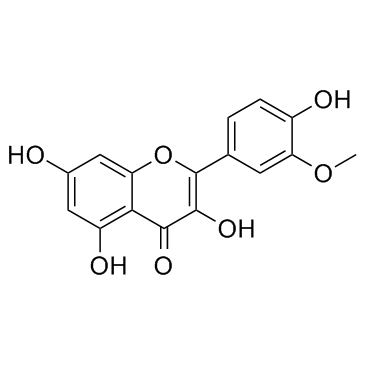
Isorhamnetin structure
|
Common Name | Isorhamnetin | ||
|---|---|---|---|---|
| CAS Number | 480-19-3 | Molecular Weight | 316.262 | |
| Density | 1.6±0.1 g/cm3 | Boiling Point | 599.4±50.0 °C at 760 mmHg | |
| Molecular Formula | C16H12O7 | Melting Point | 307°C | |
| MSDS | Chinese USA | Flash Point | 227.8±23.6 °C | |
| Symbol |

GHS08 |
Signal Word | Warning | |
Use of IsorhamnetinIsorhamnetin is a flavonoid compound extracted from the Chinese herb Hippophae rhamnoides L.. Isorhamnetin suppresses skin cancer through direct inhibition of MEK1 and PI3K. |
| Name | isorhamnetin |
|---|---|
| Synonym | More Synonyms |
| Description | Isorhamnetin is a flavonoid compound extracted from the Chinese herb Hippophae rhamnoides L.. Isorhamnetin suppresses skin cancer through direct inhibition of MEK1 and PI3K. |
|---|---|
| Related Catalog | |
| Target |
MEK1 PI3-K |
| In Vitro | Isorhamnetin is a plant flavonoid that occurs in fruits and medicinal herbs. Isorhamnetin binds directly to MEK1 in an ATP-noncompetitive manner and to PI3-K in an ATP-competitive manner. In vitro and ex vivo kinase assay data show that Isorhamnetin inhibits the kinase activity of MAP/ERK kinase (MEK) 1 and PI3-K and the inhibition is due to direct binding with Isorhamnetin[1]. Isorhamnetin inhibits the Akt/mTOR and MEK/ERK signaling pathways, and promotes the activity of the mitochondrial apoptosis signaling pathway. The inhibitory effects of Isorhamnetin on breast cancer cells are determined using the CCK-8 method. Isorhamnetin inhibits the proliferation of numerous breast cancer cells (IC50, ~10 µM), including MCF7, T47D, BT474, BT-549, MDA-MB-231 and MDA-MB-468, whereas less inhibitory activity is observed in the MCF10A normal breast epithelial cell line (IC50, 38 µM)[2]. |
| In Vivo | Photographic data shows that Isorhamnetin treatment suppresses tumor development in mice. The average volume of tumors in untreated mice increases over time and reaches a volume of 623 mm3 at 4 weeks post-inoculation; however, at this time, in mice treated with 1 or 5 mg/kg Isorhamnetin, the average tumor volume is only 280 or 198 mm3, respectively. At the end of the study, Isorhamnetin treatment (1 or 5 mg/kg) reduces tumor weight compared with the untreated control group[1]. |
| Cell Assay | MCF7, T47D, BT474, BT-549, MDA-MB-231 and MDA-MB-468 breast cancer cell lines, as well as a MCF10A normal breast epithelial cell line (control) are seeded into 96-well plates at a density of 5×103 cells/well in 100 µL DMEM and placed in cell incubator for 12 h at 37°C in an atmosphere containing 5% CO2. The cells are then treated with various concentrations of Isorhamnetin (100, 33.3, 11.1, 3.7, 1.2, 0.4 and 0 µM) for 48 h, and cell proliferation rates are determined by adding 10 µL CCK-8 solution prior to incubation at 37°C for 2 h. The absorbance is measured at a wavelength of 450 nm using a SpectraMax 190 Microplate Reader. For each assay, four parallel wells are included, and the half maximal inhibitory concentration (IC50) is measured using the inhibition curve and presented as the mean of three independent experiments[2]. |
| Animal Admin | Mice[1] Female athymic nude mice are injected subcutaneously in the flank with A431 cells (1×106 cells in 50 μL of medium and 50 μL of Matrigel). Cells are allowed to form tumors, and once the tumors reach a size of 40 mm3, the mice are randomly assigned into groups (6 mice/group) and treated with (1 or 5 mg/kg body weight) or without Isorhamnetin in 40% DMSO/PBS buffer, administered intraperitoneally every other day for 28 days. Tumor size is measured every week with calipers, and the tumor volume is calculated. Mice are sacrificed after 28 days of treatment when the control tumors reach approximately 600 mm3. The tumors are harvested, photographed, and weighed. Tumor tissues are used for western blot analysis and immunohistochemical analysis. |
| References |
| Density | 1.6±0.1 g/cm3 |
|---|---|
| Boiling Point | 599.4±50.0 °C at 760 mmHg |
| Melting Point | 307°C |
| Molecular Formula | C16H12O7 |
| Molecular Weight | 316.262 |
| Flash Point | 227.8±23.6 °C |
| Exact Mass | 316.058289 |
| PSA | 120.36000 |
| LogP | 1.76 |
| Vapour Pressure | 0.0±1.8 mmHg at 25°C |
| Index of Refraction | 1.741 |
| Storage condition | 2-8°C |
CHEMICAL IDENTIFICATION
HEALTH HAZARD DATAACUTE TOXICITY DATA
MUTATION DATA
|
| Symbol |

GHS08 |
|---|---|
| Signal Word | Warning |
| Hazard Statements | H351 |
| Precautionary Statements | P280 |
| Personal Protective Equipment | Eyeshields;full-face particle respirator type N100 (US);Gloves;respirator cartridge type N100 (US);type P1 (EN143) respirator filter;type P3 (EN 143) respirator cartridges |
| Hazard Codes | Xi |
| Risk Phrases | R36/37/38 |
| Safety Phrases | S22 |
| RIDADR | NONH for all modes of transport |
| RTECS | LK9275450 |
| Precursor 9 | |
|---|---|
| DownStream 4 | |
|
Antiviral effect of methylated flavonol isorhamnetin against influenza.
PLoS ONE 10(3) , e0121610, (2015) Influenza is an infectious respiratory disease with frequent seasonal epidemics that causes a high rate of mortality and morbidity in humans, poultry, and animals. Influenza is a serious economic conc... |
|
|
Isorhamnetin protects against oxidative stress by activating Nrf2 and inducing the expression of its target genes.
Toxicol. Appl. Pharmacol. 274(2) , 293-301, (2014) Isorhamentin is a 3'-O-methylated metabolite of quercetin, and has been reported to have anti-inflammatory and anti-proliferative effects. However, the effects of isorhamnetin on Nrf2 activation and o... |
|
|
Effects of isorhamnetin on tyrosinase: inhibition kinetics and computational simulation.
Biosci. Biotechnol. Biochem. 76(6) , 1091-7, (2012) We studied the inhibitory effects of isorhamnetin on mushroom tyrosinase by inhibition kinetics and computational simulation. Isorhamnetin reversibly inhibited tyrosinase in a mixed-type manner at Ki=... |
| 3 4' 5 7-tetrahydroxy-3'-methoxy flavone |
| MFCD00017310 |
| 3,5,7-Trihydroxy-2-(4-hydroxy-3-methoxyphenyl)-4H-1-benzopyran-4-one |
| isorhamnetine |
| 3,4',5,7-tetrahydroxy-3'-methoxyflavone |
| EINECS 207-545-5 |
| 3-methylquercetin |
| 3,5,7-Trihydroxy-2-(4-hydroxy-3-methoxyphenyl)-4H-chromen-4-one |
| quercetin-3'-methyl ether |
| ISOHAMNETIN |
| 3'-O-Methyl Quercetin |
| Isorhanetin |
| 4H-1-Benzopyran-4-one, 3,5,7-trihydroxy-2-(4-hydroxy-3-methoxyphenyl)- |
| Isorhamnetin |
| 3'-methylquercetin |
| iso-rhamnetin |
| 3'-Methoxy-3,4',5,7-tetrahydroxyflavone |
| Isorhamnetol |
| 3'-methoxykaempferol |
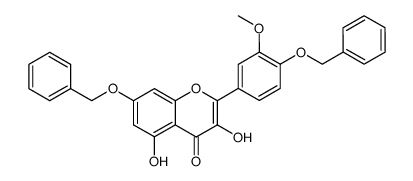 CAS#:78386-02-4
CAS#:78386-02-4![5,7-dihydroxy-2-(4-hydroxy-3-methoxyphenyl)-8-methoxy-3-[(2S,3R,4S,5R,6R)-3,4,5-trihydroxy-6-(hydroxymethyl)oxan-2-yl]oxychromen-4-one Structure](https://image.chemsrc.com/caspic/340/103839-19-6.png) CAS#:103839-19-6
CAS#:103839-19-6 CAS#:6743-92-6
CAS#:6743-92-6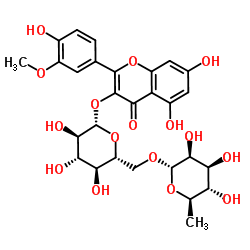 CAS#:604-80-8
CAS#:604-80-8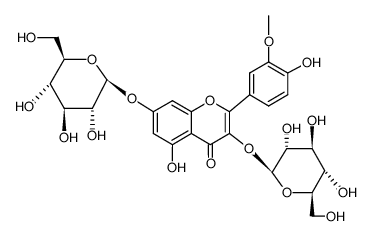 CAS#:6758-51-6
CAS#:6758-51-6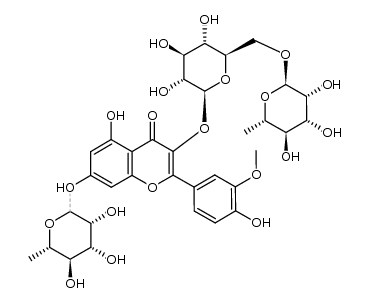 CAS#:107603-09-8
CAS#:107603-09-8 CAS#:153-18-4
CAS#:153-18-4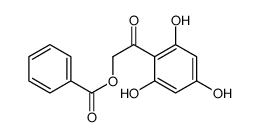 CAS#:65982-77-6
CAS#:65982-77-6 CAS#:1334307-40-2
CAS#:1334307-40-2 CAS#:108-73-6
CAS#:108-73-6 CAS#:99-50-3
CAS#:99-50-3 CAS#:117-39-5
CAS#:117-39-5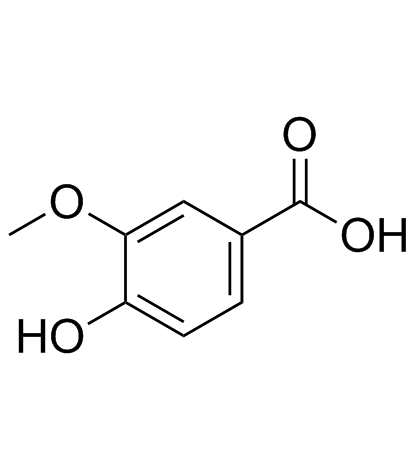 CAS#:121-34-6
CAS#:121-34-6
